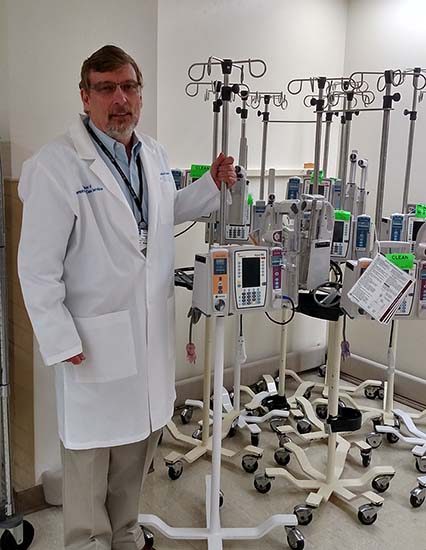
Thanks to state-of-the-art ETCO2 monitoring technology, rapid response team calls have been cut in half at one California hospital, and respiratory therapists are driving the process.
The monitoring went into operation at White Memorial Medical Center in Los Angeles after concerns began to be raised at Adventist Health, parent company of the hospital, about the risk of respiratory depression among patients receiving patient-controlled analgesia (PCA) or moderate sedation during procedures. Corporate officials sent out a request to member hospitals to find out if they were interested in a new technology aimed at monitoring both oxygen saturation and ventilatory status in these patients.
At his hospital, the result was an overwhelming yes, says Richard Kenny, MSM, RRT-NPS, RRT-ACCS, director of respiratory care services at White Memorial, and respiratory therapists quickly took ownership of the new monitoring paradigm.
Respiratory team takes control
“When the conversation on PCA and ETCO2 monitoring started, it was heard by many, including the respiratory therapist, that respiratory therapists are the experts,” says the AARC member. “There was no argument by any of the therapists that this should not be the case, and respiratory gladly took over the ETCO2 monitoring of PCA patients.”
Kenny says the combined units use an algorithm to measure both ETCO2 and oxygen saturation, allowing for a better read on the patient’s condition. “Having separate devices leads to confusion, in my opinion,” he says. “Too many numbers to look at, too many alarms, and cumbersome in taking up table space and electrical outlets. Making it simple and effective by combining is the smart choice.”
Therapists are responsible for setting up the ETCO2 device that directly attaches to the PCA device, setting alarm limits to match the patient, rounding every four hours (nurses also see the patient every four hours, which means patients are monitored every two hours by either an RT or a nurse), and documenting ETCO2 readings. Since the monitoring can take place anywhere in the hospital, all 64 therapists in the department have been trained in the service.
Rewards and challenges
The nearly 50% drop in the number of rapid response team calls has been one of the most significant outcomes from the use of this technology. “When the patient meets and crosses a set parameter, the alarm is loud and cannot be silenced until such time as a nurse or therapist is at the bedside to ensure the patient is awake and able to respond appropriately,” says Kenny.
Should the alarm sound again in a short period of time, a request for a change in medication is called in to the physician. “It should be noted that when the ETCO2 device alarms, the PCA device is placed in automatic standby mode,” adds Kenny. “It cannot be restarted until an evaluation of the patient has been done and it is determined safe to restart the pump.”
The biggest challenge he and his colleagues faced in implementing the monitoring was the tendency of patients to want to remove the cannula. “Patients find it uncomfortable and inconvenient at first, especially as they begin to awake post op,” says Kenny.
Initially therapists and nurses had a hard time understanding why patients would try to remove the cannula when they had been instructed not to do so, but after they realized that patients are often too groggy at first to understand what’s being told to them, they bought into the idea that re-education would be necessary. That solved the problem. “Now that time has passed and all understand the importance of this technology and how it prevents unwanted situations, there is no issue,” says the RT manager.
What’s next for RT driven monitoring
Since beginning the monitoring with PCA and conscious sedation patients, the hospital is now looking at using the technology on any patient where respiratory depression is a concern. “As conversations took place and policies went through the approval process, questions were raised of, ‘why not this patient or that patient?’” he says. “That’s when it was decided to expand the monitoring process with ETCO2. It’s the right thing to do.”
Are you passionate about patient safety? Join the Patient Safety Roundtable Discussion on AARConnect.
Join the Roundtable Discussion
Email newsroom@aarc.org with questions or comments, we’d love to hear from you.










